New Jersey
The Dutch arrived in New Jersey in the early 17th century to trade furs with the indigenous Indians. They claimed the coastal area from east of Rhode Island to Maryland as their colony of New Netherland. In 1664 an English fleet took New Amsterdam (now New York) and annexed the whole Dutch colony. In 1665 the Duke of York was granted land that included the former New Netherland, but he owed money to Sir George Cartaret so he gave him a section of land between the Hudson and Delaware Rivers to in settlement of the debt. Cartaret named the territory after the island of Jersey which was his ancestral home. The Duke of York sold the remainder of the land that now forms New Jersey to Lord Berkeley of Stratton. This created East Jersey and West Jersey, which in 1702 were united as the single Royal colony of New Jersey. Come the Revolutionary War, the New Jersey Provincial Congress jumped the gun by passing a new constitution on July 2, 1776, two days before the Declaration of Independence was published. To keep their options open the new constitution automatically became void if a settlement was reached with Britain. New Jersey was admitted as a US state on December 18, 1787. If your only experience of New Jersey is the relentless industrial sprawl between Newark airport and the Lincoln Tunnel you are in for a surprise. New Jersey is known as the Garden State and once you get away from the part close to New York it lives up to its name. Oh, and there’s Atlantic City, the East Coast’s answer to Las Vegas.
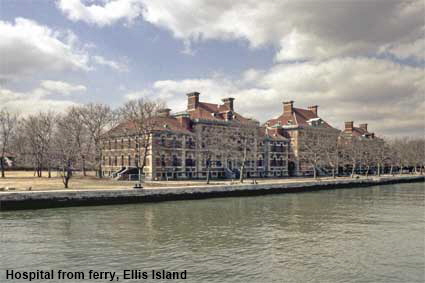
DLU170410
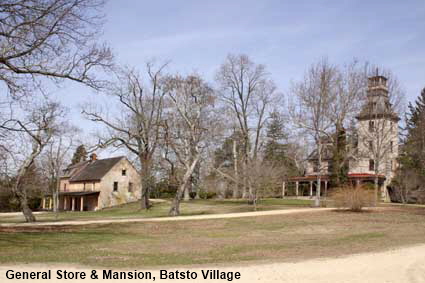
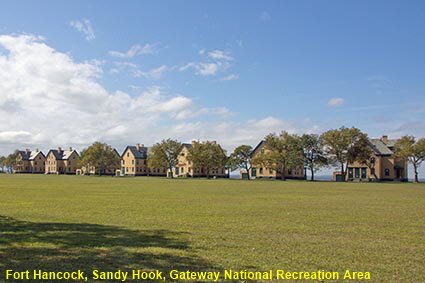
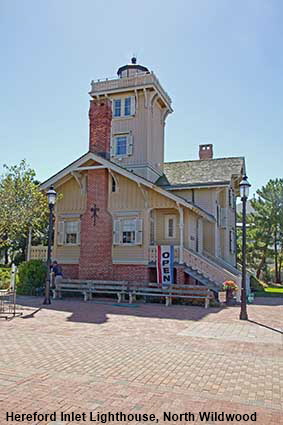
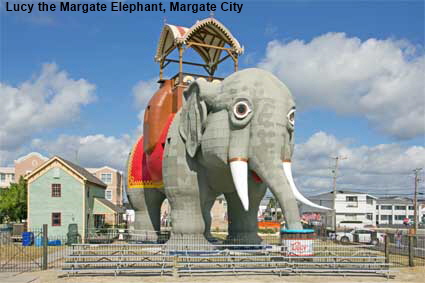
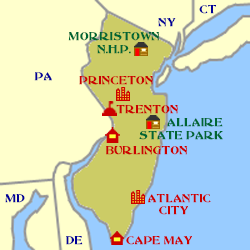
Home > US States > Midatlantic USA >
Click on Minimap to navigate
Fort Hancock, Sandy Hook, Gateway National Recreation Area
Sandy Hook is a peninsula projecting north from New Jersey into the Lower New York Bay. Because it was close to the deep water shipping channel into New York City, the peninsula had considerable maritime and military significance. The Colony of New York built a lighthouse on the peninsula in 1764. The British held Sandy Hook during the Revolutionary War then after independence was won the US military moved in. During the War of 1812 the British used their naval power to raid coastal areas so in 1813 Fort Gates was built on Sandy Hook to defend the approach to New York. Fort Gates was built of timber but at the end of the war plans were made to build a more permanent fort. It was not until 1859 that work began to build the Fort at Sandy Hook, but the Civil War resulted in the building work being abandoned. From 1890 several concrete gun batteries were built on Sandy Hook and in 1895 the defences were given the name Fort Hancock. Yellow brick buildings to house military personnel were built between 1898 and 1910. Fort Hancock reached its peak during World War II but it was decommissioned at the end of 1974. It now forms part of the Sandy Hook unit of Gateway National Recreation Area. Click Tab 2 to see Sandy Hook Lighthouse.
Great Falls & Bridge from Spruce Street, Paterson
Although New Jersey is known as the Garden State, it also has a long industrial history. The early USA had a major problem; the colonies had been highly dependent on Britain for industrial goods and hence it needed quickly to develop its own industrial capability. In the 1700s the key to this was water power and the 23 metre (77 foot) high Great Falls of the Passaic River were an ideal source. Alexander Hamilton, who later became US Secretary of Treasury, visited the falls in 1778 and was impressed by the potential to develop industry at the site. In 1791 he helped to found the Society for the Establishment of Useful Manufactures to manage the development of the falls as source of power for manufacturing. The society established the town of Paterson alongside the falls, naming it after William Paterson who signed the US Constitution and at the time was Governor of New Jersey. Raceways were built to channel water to mills, and Paterson thrived first on cotton, then steel and finally silk manufacturing. The mills at Paterson remained water powered until 1914. After World War II Paterson went into decline. In 2009 the falls and some of the historic mills around them became Paterson Great Falls National Historical Park.
Hereford Inlet Lighthouse, North Wildwood
North Wildwood is home to an unusual historic lighthouse that still guides ships through Hereford Inlet. The inlet connects the Atlantic Ocean to the Intra-Coastal Waterway that runs down the east coast of the USA. Sandbanks and strong currents in the inlet resulted in many shipwrecks and in 1849 a Life Saving Station was built on the south shore of the inlet to rescue shipwrecked mariners. This was replaced by a larger station in 1871, but by then it was clear that measures needed to be taken to reduce the number of shipwrecks so in 1872 Congress authorised the purchase of land on the south shore of the inlet to build a lighthouse. The Chief Draftsman of the Lighthouse Board, Paul J. Pelz, designed Hereford Inlet Lighthouse in the form of a timber lightkeepers house with and integrated square tower rather than the more common stand-alone cylindrical tower. It is the only lighthouse of this design on the east coast of the USA. Hereford Inlet Lighthouse came into service in 1874 and was in service for 90 years. It had to be moved a short distance in 1913 due to damage to its original foundations. In 1964 an automated beacon was placed nearby, the lighthouse closed and was left derelict for 18 years. The City of North Wildwood took over the former lighthouse in 1982 and immediately began restoration work. In 1986 the light from the automated beacon was moved to the lighthouse tower, making it an operational lighthouse once again. The lightkeepers house has been turned into a museum and it is open to the public.
Lucy the Margate Elephant
The Victorians loved exotic buildings, especially at the seaside, and this 20 metre (65 foot) high wood framed and tin covered elephant is an excellent example. Built on the South Atlantic City (now Margate City) sea front in 1881 by James Lafferty, Lucy the Elephant was the first of three such structures. It is now the only survivor as the other two built at Coney Island and Cape May have long gone. Damaged by storms in 1929 and 1962 it was restored and moved to a park in the 1970s. Tours are available, entering the building through one back leg, up a winding staircase to the main reception room, and back down through the other leg.
General Store & Mansion, Batsto Village
Batsto was founded in 1766 as an iron making centre and it played a significant role in supplying the Continental Army during the American Revolution. In the mid 19th century, iron making had declined and Batsto branched out into the manufacture of glass for windows. Glassmaking was short lived and in 1876 the area was bought by Joseph Wharton, who developed it for agricultural purposes, including building a sawmill. The Iron Furnaces and Glassworks have long gone, but the switch to agriculture ensured that the Mansion, General Store, Mills and Workers Houses have survived and are now preserved as a State Historic Site.
Ellis Island Hospital
Ellis Island is where from 1892 to 1954 over 12 million immigrants were processed before settling in the USA. But hold on you may say, Ellis Island is in New York isn’t it? Well, it ain’t as simple as that. It is situated well inside the New Jersey side of the boundary that runs down the middle of the Hudson River, but for years it was assumed that the island was in New York. In 1998 the Supreme Court ruled that the original 1.3 hectares (3.3 acres) of Ellis Island including the Main Hall and Museum were indeed in New York, but the 9.8 hectares (24.2 acres) that were created by landfill were in New Jersey. Since the island is now a National Park owned by the Federal Government it all seems academic to us outsiders, but it mattered to New Jersey.
Proprietary House, Perth Amboy
At the mouth of the Raritan River is a peninsula that the Lenape Indians called Ompoge. When Europeans arrived the name became Emboyle then Amboyle and by the time Scottish settlers arrived in 1684 it was known as Amboy Point. The Scottish proprietors of the land decided to call the town New Perth in honour of one of their number, the Earl of Perth. Neither name won the day, instead the town became Perth Amboy. Between 1762 and 1764 a mansion was built in Perth Amboy for the Royal Governor of New Jersey. In 1762 King George III appointed William Franklin to that post. He was the illegitimate son of Benjamin Franklin who had accompanied his father during his famous kite experiment. William and his wife Elizabeth didn’t move into the mansion known as Proprietary House until 1774. When relations with Britain deteriorated in 1775, Benjamin Franklin visited Perth Amboy to try to persuade his Loyalist son to support independence. His mission was in vain and in January 1776 William was put under house arrest. He was convicted of treason but released in 1778. He remained a Loyalist after his release but moved to England in 1782. Proprietary House was damaged by fire in the 1780s but businessman John Rattoone bought it in 1794 and repaired it. The house passed through several different hands and was used for many different functions before in 1967 it was bought by the State of New Jersey. Proprietary House is open to the public Wednesday afternoons and some Sunday afternoons.
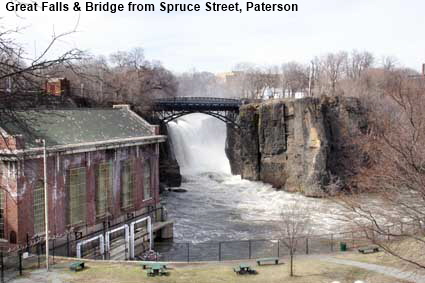


We have other pages on New Jersey. Click below or on the Minimap:
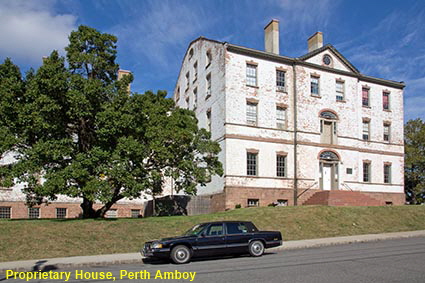
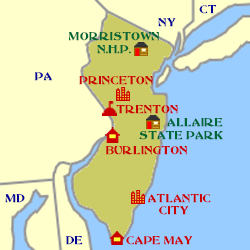
© Mike Elsden 1981 - 2025
The contents of this page may not be reproduced in full or in part without permission